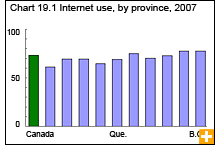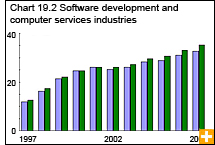Common menu bar links
Information and communications technology
Archived Content
Information identified as archived is provided for reference, research or recordkeeping purposes. It is not subject to the Government of Canada Web Standards and has not been altered or updated since it was archived. Please contact us to request a format other than those available.
Information and communications technologies are penetrating ever more deeply into the social fabric. Canadians are using the Internet for more and more purposes, but a digital divide persists based on income, education and age.
Seventy-three percent of those aged 16 and older, or 19.2 million Canadians, went online for personal reasons in 2007, compared with 68% of those aged 18 and older in 2005.
Of Canadians in the highest income group (households earning more than $95,000), 91% used the Internet, compared with 47% of those in the lowest group (households earning less than $24,000).
Eighty-four percent of people with at least some postsecondary education accessed the Internet in 2007, compared with 58% of those with less education.
Internet use rose among all age groups from 2005 to 2007. However, 96% of young people aged 16 to 24 went online, compared with 29% of those 65 and older.
Browsing, blogging, chatting, and downloading
E-mail and general browsing are the most popular online activities at home. Finding government or health information, making travel arrangements, banking, and ordering goods and services are also popular uses of the Internet.
Moreover, 20% of home Internet users reported posting images, writing blogs, or participating in discussion forums in 2007. More than half of these content contributors were under the age of 30.
Some 50% of home Internet users used an instant messenger during 2007. Again, relatively more young people did so. The growth in broadband services has also facilitated downloading of music, movies and television shows.
Service providers seeing growth
This ever-rising Internet use has meant sustained growth for Canada’s Internet service providers.
Revenues from providing Internet services reached $5.7 billion in 2007, up 13% from 2006. The residential market was by far the largest, generating almost 64% of Internet service revenues in 2007.
High-speed service continues to gain popularity among residential users. In 2007, 90% of them chose high-speed services, up from nearly 65% in 2003. High-speed customers accounted for 94% of residential revenues in 2007, up from nearly 75% in 2003.
In 2007, 59% of high-speed subscribers chose plans with an advertised top speed of 5 megabits per second (mbps) to 9 mbps, a range that enables users to download or view online movie rentals or purchases, and may enable them to view certain low-bandwidth forms of high-definition video. Approximately 500 Internet service providers operate in Canada, but the top five captured 77% of Internet access revenues in 2007.




